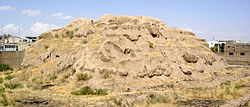Meimoon Ghal'eh
Meimoon Ghal'eh is a ruined castle in the south of the city of Qazvin and belongs to the province of the same name in Iran .
The ruin is located in the city of Qazvin, which is why it has been severely attacked by exhaust gases and other air pollution . It is located on an area of 5000 m². What remains of the former structure suggests that a large dome must have been present. There is nothing left of the ceilings. The fortification, on the other hand, has an underground network of three east-west aligned tunnels, which are crossed by a tunnel running north-south. The different levels were connected by spiral staircases. It is assumed that the main entrances to the property must have been on the north side. The domed building was flanked by eight brick towers. Apparently the building served military purposes.
The date of manufacture of the system is unknown, but the era of is Abbasids - Caliphate assigned (starting in the 8th century). It is believed that Musa al-Hādī commissioned the construction of the castle around the year 784. Other experts put the origin of the castle in the later Buyid era (around 930 to 1062), which is indicated by tools that were excavated from the side of the structure.
In the 13th century, the natural scientist and Shiite theologian Nasir ad-Din at-Tusi spent some time in the property while fighting on the side of the Mongols against the assassins .
See also
Individual evidence
- ↑ Pictures can be found in the English Wikipedia.
- ^ SH Nasr, Oliver Leaman, History of Islamic Philosophy , 1993, ISBN 0-415-25934-7 , p. 530.
Web links
Coordinates: 36 ° 15 ′ 18 ″ N , 50 ° 0 ′ 11 ″ E
